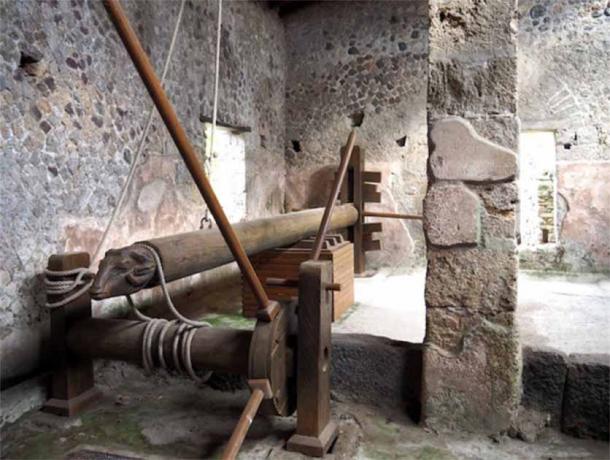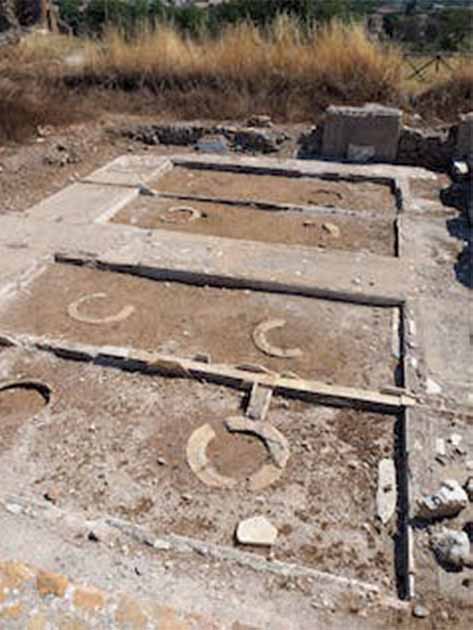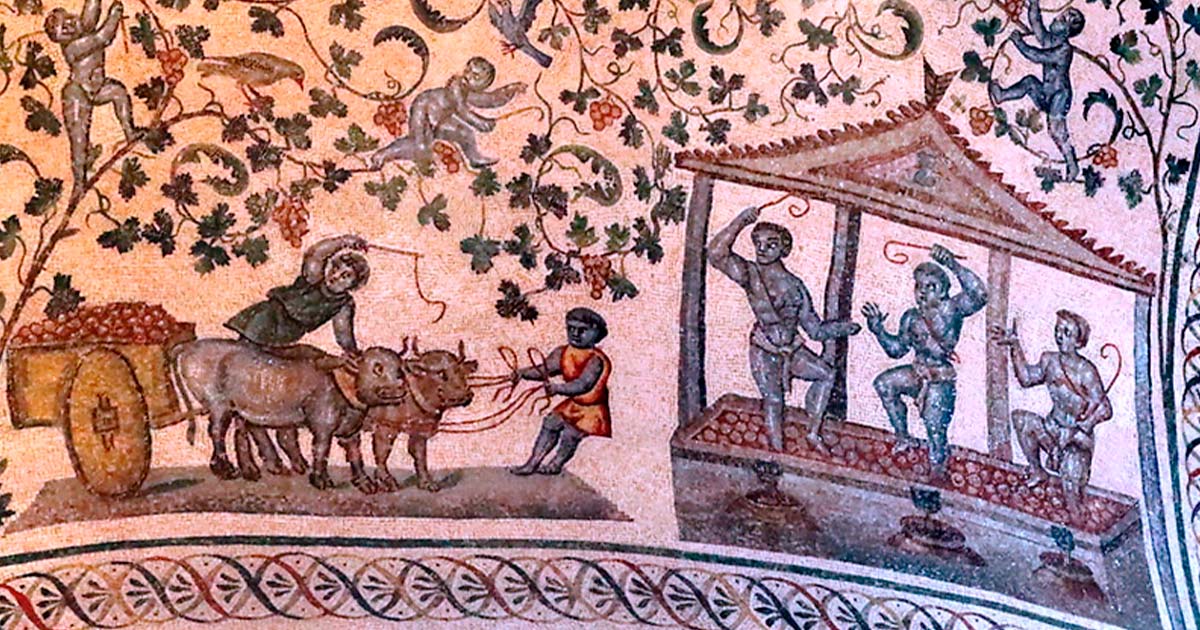Opulent Roman Winery With Fountains of Grape Juice Uncovered
Emlyn Dodd/The Conversation
Recent excavations at the Villa of the Quintilii uncovered the remains of a unique winery just outside Rome.
The mid-third-century AD building located along the Via Appia Antica portrays a sense of opulence and performance almost never found at an ancient production site.
This exciting complex illustrates how elite Romans fused utilitarian function with luxurious decoration and theatre to fashion their social and political status.
I was one of the specialist archaeologists to study this newly excavated site. The details of this discovery are outlined in our new article in Antiquity.

View of the excavated winery at the Villa of the Quintilii on the Via Appia Antica, Rome. S. Castellani. (The Conversation/Author provided)
The Villa of the Quintilii
From names stamped on a lead water pipe, we know the 24 hectare ancient Roman villa complex was owned by the wealthy Quintilii brothers, who served as consuls in 151 AD.
The Roman emperor Commodus had the brothers killed in 182/3 AD.
He took possession of their properties, including this villa, initiating long-term imperial ownership.
The site has been long known for its decorative architecture, including colored marble tiling, high-quality statuary recovered over the last 400 years, and a monumental bathing complex.
Less known is an enormous circus for chariot racing built during the reign of Commodus.
From 2017-18, during an attempt to discover the starting gates of the circus, the first traces of a unique winery were revealed.
- 2000-Year-Old Bronze Toy Provides Clues on How the Best Roman Chariots were Constructed
- Taraxippus, the Terrifying Horse Scarer: Apparition Appeared Across Racetracks in Ancient Greece
A luxury Roman imperial winery
This large complex was built on top of the circus starting gates, which dates it after the reign of Commodus.
The complex possesses features commonly found in ancient Roman wineries: a grape treading area, two wine presses, a vat to collect grape must (the juice of the grapes along with their skins, seeds and stems) and a cellar with large clay jars for storage and fermentation sunk into the ground.
However, the decoration and arrangement of these features is almost completely unparalleled in the ancient world.

Aerial view of the excavated winery at the Villa of the Quintilii. Production areas are at the top (A–D), and the cellar (E) with adjacent dining rooms (F) in the lower half of the image. (Photo by M.C.M s.r.l and adaptation in Dodd, Frontoni, Galli 2023, Author provided)
Nearly all the production areas are clad in marble veneer tiling. Even the treading area, normally coated in waterproof cocciopesto plaster, is covered in red breccia marble. This luxurious material, combined with its impracticalities (it is very slippery when wet, unlike plaster), conveys the extreme sense of luxury.

Reconstructed ancient Roman wine press at the Villa of the Mysteries, Pompeii, Italy. (E. Dodd, Author provided)
Two immense mechanical lever presses sit either side of the treading area to press the already trodden grape pulp.
The size and scale of these presses working up and down in harmony would have contributed to the theatre of the production process.
The grape juice produced from treading and pressing flowed from these areas into a long rectangular vat, where an impression from a stamp named the short-reigning emperor Gordian (deposed 244 AD). This confirms a date of construction or renovation.
But it is here the real performance would have begun.
The liquid grape must poured like a striking fountain out of the vat and through a facade around one meter in height that closely resembles a Roman nymphaeum (a monumental decorated fountain).

View from the excavated dining room over the cellar with its facade of niches and fountains and up to the raised production areas. (E. Dodd, Author provided)
While must flowed out of the three central niches, water flowed out of those on either end, and was then channeled back underground through a system of lead pipes.
This niched facade was originally clad in a decorative veneer of brightly colored white, black, grey and red marble. Some pieces remain attached, and more were found loose in the excavated layers.

The cellar with marble-lined distribution channels and eight buried clay jars reinstated in their original positions. (E. Dodd, Author provided)
A system of thin open white marble channels conveyed the grape must from the facade into an open-air cellar area.
Here it was fed into 16 buried clay jars ( dolia defossa) large enough for a person to fit inside. The remains of eight were uncovered during excavations.
Three rooms paved in opulent geometric marble tiling, like those found in other areas of the villa, were arranged around the cellar.
We might imagine the emperor and his retinue reclining, eating and watching the spectacle of production and tasting freshly pressed must.

Geometric coloured marble floor tiling (opus sectile) discovered in one of the dining rooms. (S. Castellani, Author provided)
Theatrical Vintage Ritual in Ancient Italy
The only other example like this facility can be found at Villa Magna, 50 kilometers to the south-east near Anagni.
This similarly opulent marble-clad winery was in use just before the Villa of the Quintilii, from the early second to early third century AD, with an area for dining that enabled a view of the production spaces.
In Marcus Aurelius’ letters to his tutor Fronto, we are given a rare glimpse into the activities of Villa Magna around 140-145 AD. He describes the imperial party banqueting while watching and listening to the workers treading grapes.
- Mimicking Gods and Gladiators: The Assassination Of Emperor Commodus
- 5 Celebrity Gladiators of Bloodthirsty Ancient Rome
It is likely this formed part of a vintage ritual, tied to the ceremonial opening of the harvest. Perhaps this ritual also occurred at the slightly later Villa of the Quintilii facility.
Lavish marble-clad spaces marked areas fit for the imperial party and the winery was the “theatre” for this sacred performance.
One tantalizing question remains unanswered: was the Roman emperor’s spectacular, ritual winery moved in the early third century CE from Villa Magna to the Villa of the Quintilii?
This article was originally published under the title ‘A newly uncovered ancient Roman winery featured marble tiling, fountains of grape juice and an extreme sense of luxury’ by Emlyn Dodd on The Conversation, and has been republished under a Creative Commons License.
Top image: Roman mosaic illustrating a winemaking scene from the fourth century AD at Santa Costanza, Rome. Source: Jean Louis Mazieres/ CC BY-NC-SA 2.0

















Comments
You think everything is pre-Roman Atlantean Era. I believe the timeline the archeologists have researched.
Of course, ‘Roman’ is what they call everything they dig up around the Med, even in light of there being ZERO evidence of the Romans constructing any substantial complexes from the ground up (but instead occupying what were existing structures or ruins at the time). So this find would similarly have to be of pre-Roman/Atlantean era, and lying under that much sediment (the science provides expected rates of accumulation), it probably goes back tens of thousands of years. A good guess would be, it was last used just prior to the Atlantis event described by Plato, circa 115k BC, adding the zero back to his timeline.
But this is a GREAT example of how the pre-Ice Age ancient Greeks lived, quite opulently despite the simplicity of the technology. With this mural (https://www.ancient-origins.net/sites/default/files/field/image/Roman-wi...), which is typical of that era, we see the wooden cart pulled by domesticated oxen, delivering grapes to be processed the traditional way – via young feet! It seems the children were a big part of wine-making. Ask kids today, would you rather be sitting in a dismal classroom, force-fed boring information, or outside under the sun, making wine for the elders? The question becomes, can we go back?
Nobody gets paid to tell the truth.